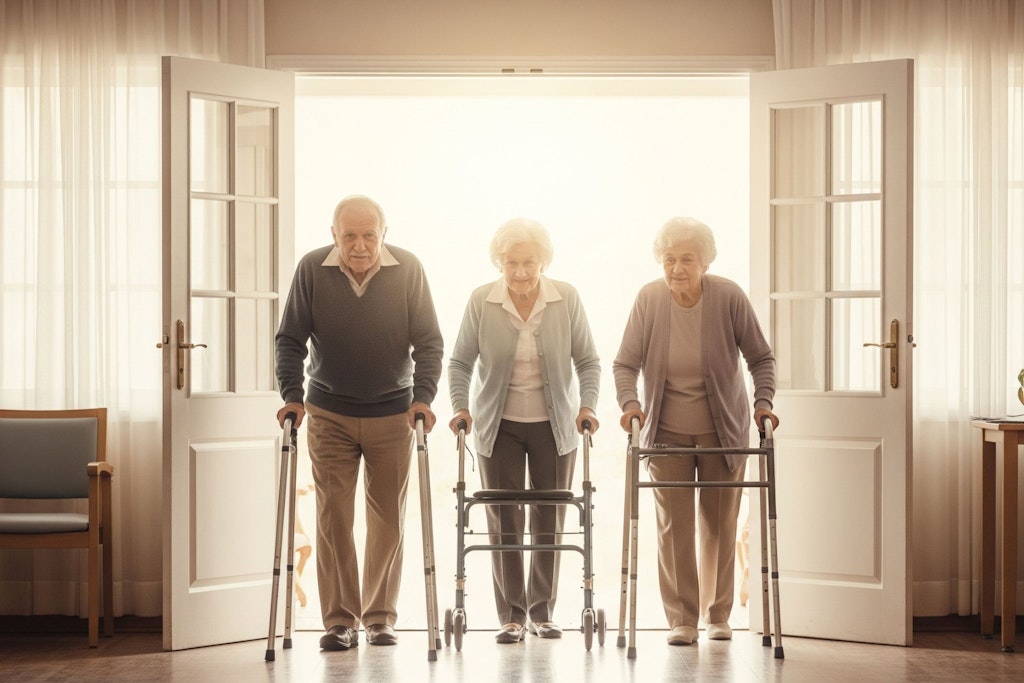Breaking the shackles: Risking unlocking the doors in aged care can be worth the reward
Last updated on 16 July 2025

The use of locked doors in aged care facilities, particularly for residents living with dementia, has long been a standard practice justified by safety concerns. However, a growing movement within the sector is challenging this norm, advocating for a shift towards environments that prioritise autonomy, dignity, and freedom.
Marie Alford, General Manager of Growth, Innovation, Advisory Care & Partnerships at HammondCare, and advocates like Michael Page, co-founder of Open the Doors 2030 and Nicole Smith, founder of Open the Doors 2030, are at the forefront of this debate, urging providers to rethink the balance between risk and residents’ rights.
Safety and autonomy: A balancing act
Locked doors in aged care, especially in Memory Support Units (MSUs), are often implemented to prevent residents with dementia from wandering or to protect other residents from disruptive behaviours. Yet, as Alford points out, this practice can sometimes reflect routine rather than necessity.
“Too often, doors remain locked not because they need to be, but because they always have been,” she says, highlighting how institutional habits and fear of liability can overshadow person-centred care.
Alford’s perspective is informed by both her professional role and personal experiences as a carer for someone with dementia. She recalls observing residents with dementia watching keypads at facility exits, their awareness of the barrier evident in their expressions.
“That moment says more about autonomy, memory, and control than any clinical assessment ever could,” she notes. Such observations underscore the emotional toll of restricted environments, which can trigger distress, disorientation, or even past trauma for residents.
Michael Page echoes this sentiment, arguing that locked doors often exacerbate the behaviours they aim to control. “If you’re providing dementia care and you have to have locked doors, you don’t understand dementia,” he asserts.
Page, a registered nurse and clinical educator, points to the example of Ananda Aged Care in Adelaide, where MSUs transitioned to open-door policies in 2018 and 2019. The results were striking: a 50% reduction in behaviours requiring incident response and a 90% increase in staff confidence and satisfaction. Residents, previously fixated on locked exits, found peace in exploring broader spaces, with one even assisting staff by posting flyers around the facility.
The case for locked doors: A necessary evil?
Despite the push for open environments, some argue that locked doors remain essential in certain contexts. Aged care consultant Kathryne Turek, commenting on Page’s article, emphasises the risks of unrestricted movement in facilities without adequate staffing or dementia-specific training.
“Having confused people wandering around a large expanse without the appropriately skilled and staffed ratio places them and other older frail people at risk,” she warns, citing coroner’s cases involving harm caused by insufficient supervision.
Julie Long’s experience further illustrates this concern. Her bedbound mother, who had advanced dementia, faced repeated intrusions from mobile residents with dementia in a facility without an MSU. Incidents included physical altercations and unsanitary behaviours, culminating in a staff member being stabbed by a confused resident.
“All aged care residents have the right to quality care and to live in a safe and comfortable environment,” Long stresses, highlighting the need for secure environments to protect vulnerable residents.
Alford acknowledges that locked doors can sometimes be the “least restrictive option” in specific cases, such as when a resident’s compulsive wandering leads to dehydration or disorientation. However, she insists that such measures must be justified, time-limited, and regularly reviewed.

Pictured: Marie Alford (supplied)
“Balancing safety and autonomy isn’t about choosing one over the other,” she explains. “It’s about asking how we can honour a person’s right to freedom while thoughtfully managing risk in a way that upholds dignity, identity, and wellbeing.”
Practical alternatives to locked doors
To move away from blanket restrictions, Alford advocates for a range of practical alternatives that prioritise freedom while maintaining safety. These include designing secure outdoor spaces where residents can move freely, using environmental cues to enhance wayfinding, and tailoring activities to reduce restlessness.
Technology, such as wearable devices or door sensors, can discreetly alert staff without resorting to locks. Individual risk assessments and partnerships with families are also critical to understanding residents’ needs and preferences.
Ananda Aged Care’s success with open doors was supported by a year-long training package from Dementia Training Australia, which included environmental assessments to reduce confusion and enhance engagement.
Similarly, Alford suggests quarterly audits of restrictive practices, regular discussions in team meetings, and feedback from residents and families to ensure locked doors are justified and phased out when possible.
Commenters on Page’s article, such as Amina Schipp, propose even bolder changes, like adopting small-scale housing models seen in the Netherlands and Scandinavia. These models prioritise homelike environments with dementia-competent staff and realistic staff-to-resident ratios, fostering person-centred care over institutional control.
Overcoming Barriers to Change
The biggest barrier to prioritising freedom, according to Alford, is a “fear-driven culture” rooted in concerns about falls, liability, or non-compliance. This fear is compounded by staffing shortages and task-oriented workflows, as noted by commenter James Jones, who observes that locking doors is often an “easy” way to manage limited resources.
Rosemary, a former aged care worker, adds that low pay and insufficient staffing levels hinder the ability to provide individualised care, suggesting that dedicated “walkers” could monitor residents in open environments.
To shift this culture, Alford advocates for leadership that models change. “When managers walk alongside residents, unlock a door, or support staff to try something new, they show, not just say, what’s valued,” she says.
She also points to Australia’s Strengthened Aged Care Quality and Safety Standards, which emphasise self-determination and the minimisation of restrictive practices. These standards make the least restrictive approach a compliance requirement, encouraging staff to challenge locked-door norms without fear of repercussions.
The role of residents and families
Involving residents and families in decisions about locked doors is crucial. Alford stresses that people with dementia often express their wishes non-verbally through behaviours or reactions to restricted environments.
Families, meanwhile, provide critical insights into a resident’s life story and values. “We can co-design individual risk management plans that include resident and family input,” Alford suggests, ensuring decisions reflect the person’s preferences rather than institutional convenience.
A vision for the future
The movement to unlock doors in aged care is gaining momentum, driven by advocates like Page and Alford who see freedom as a fundamental right. Page’s Open the Doors 2030 initiative calls for inclusive, dementia-enabling homes by 2030, urging providers to commit to this vision on Human Rights Day, December 10th.
Maurie Voisey-Barlin, another advocate, argues that this shift requires systemic change, not just philosophical debate. “It’s not some philosophical fancy but a question of structural and systemic change,” he writes, citing successful examples like Community Home Australia’s open facilities.
While challenges like staffing, training, and safety concerns persist, the evidence from facilities like Ananda Aged Care shows that unlocking doors can enhance residents’ quality of life and staff satisfaction.
As Alford concludes, “True compassion brings the person into focus. It reminds us that locked doors don’t just manage risk, they shape the experience for the person living with dementia.” By combining compassion with critical thinking, the aged care sector can move towards environments that prioritise dignity, autonomy, and the right to feel at home.